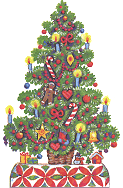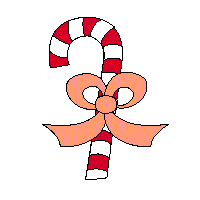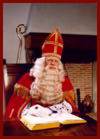 Mistletoe
and Holly
Mistletoe
and Holly 
 Mistletoe
and Holly
Mistletoe
and Holly 
Two hundred years before the birth of Christ, the Druids used mistletoe to celebrate the coming of winter. They would gather this evergreen plant that is parasitic upon other trees and used it to decorate their homes. They believed the plant had special healing powers for everything from female infertility to poison ingestion. Scandinavians also thought of mistletoe as a plant of peace and harmony. They associated mistletoe with their goddess of love, Frigga. The custom of kissing under the mistletoe probably derived from this belief. The early church banned the use of mistletoe in Christmas celebrations because of its pagan origins. Instead, church fathers suggested the use of holly as an appropriate substitute for Christmas greenery.
In winter, trees lose their leaves revealing the perennially green mistletoe. Ancient druids noted this fact. Later Christians latched onto this and proclaimed the mistletoe as symbol of eternal life.
Christian tradition assigns
significance to Holly. According to tradition the pointy leaves
represent the thorns of Christ's Crown. The perennial green
leaves represent eternal life. The red berries represent the
blood she for our salvation.
There is even a tradition that holly was used to make the crown
of thorns. At that time the berries were yellow. In honor to the
blood shed by Christ the berries turned red.
While holy is most often pictured as having red berries the
berries come in other colors too. One tradition say that white
berries represent Jesus purity, green berries the cross of wood,
and black berries his death.
![]()
 Poinsettias
Poinsettias
Poinsettias are native to Mexico. They
were named after America's first ambassador
to Mexico, Joel Poinsett. He brought the plants to America in
1828. The Mexicans in
the eighteenth century thought the plants were symbolic of the
Star of Bethlehem. Thus
the Poinsettia became associated with the Christmas season. The
actual flower of the
poinsettia is small and yellow. But surrounding the flower are
large, bright red leaves,
often mistaken for petals.
![]()
 The
Christmas Tree
The
Christmas Tree
The Christmas Tree originated in
Germany in the 16th century. It was common for the
Germanic people to decorate fir trees, both inside and out, with
roses, apples, and
colored paper. It is believed that Martin Luther, the Protestant
reformer, was the first
to light a Christmas tree with candles. While coming home one
dark winter's night
near Christmas, he was struck with the beauty of the starlight
shining through the
branches of a small fir tree outside his home. He duplicated the
starlight by using
candles attached to the branches of his indoor Christmas tree.
The Christmas tree
was not widely used in Britain until the 19th century. It was
brought to America by the
Pennsylvania Germans in the 1820's.
According to legend evergreen trees
were not always green. Before the birth of Christ they lost their
leaves each winter like other trees. But while Mary, Joseph and
Jesus were on their way to Egypt they were forced to hide from
Herod's soldiers in a clump of cedar trees. To hide the holy
family the trees brought forth green needles and the cedars white
berries turned blue so that Mary's blue robe blended in. Since
that day evergreen trees have kept their color all year round.
Another related legend says that a pine tree hid the holy family
and that the baby Jesus left the imprint of his hand forever in
their fruit and that if you cut a pine cone lengthwise you can
still see the imprint of that tiny hand.
While the legend of the origins of the Christmas tree is
interesting the history is equally fascinating. It is known that
back long before Jesus Germanic peoples would adorn evergreen
trees in winter solstice ceremonies of sorts. The origins of the
Christian Christmas Tree can be traced to St. Boniface(8th
century) who as a missionary to the Germanic tribes used the
triangular shape of evergreen trees as a symbol of the
trinity. A legend attached to this origin says that St. Boniface
came upon some people preparing to sacrifice a child to an oak
tree. In an attempt to stop the sacrifice he grabbed the
ceremonial ax and in one blow cut down the oak tree, when it fell
a small fir tree sprang from its stump. This legend is probably a
way of chronicling in story form that St. Boniface
replaced the worship of the Germanic gods, symbolized by the old
oak tree with the new Christian religion, symbolized by the
Christianized fir tree.
![]()
Xmas
This abbreviation for Christmas is of
Greek origin. The word for Christ in Greek is
Xristos. During the 16th century, Europeans began using the first
initial of Christ's
name, "X" in place of the word Christ in Christmas as a
shorthand form of the word. Although the early
Christians understood that X stood for Christ's name, later
Christians who did not understand the Greek
language mistook "Xmas" as a sign of disrespect.
The word Christmas comes from the words
Cristes maesse, or "Christ's Mass". Christmas is the
celebration of the birth of Jesus for members of the Christian
religion. Most historians peg the first celebration of Christmas
to Rome in 336 AD.
Christmas is both a holiday and a Holy Day. In America it is the
biggest event of the year (especially for kids), and for members
of the Christian religions it is an important day on the
religious calendar.
![]()
 The
Candy Cane
The
Candy Cane
In the late 1800's a candy maker in
Indiana wanted to express the meaning of Christmas
through a symbol made of candy. He came up with the idea of
bending one of his white candy
sticks into the shape of a Candy Cane. He incorporated several
symbols of Christ's love and
sacrifice through the Candy Cane. First, he used a plain white
peppermint stick. The color white
symbolizes the purity and sinless nature of Jesus. Next, he added
three small stripes to
symbolize the pain inflicted upon Jesus before His death on the
cross. There are three of them to represent the
Holy Trinity. He added a bold stripe to represent the blood Jesus
shed for mankind. When looked at with the
crook on top, it looks like a shepherd's staff because Jesus is
the shepherd of man. If you turn it upside down, it
becomes the letter J symbolizing the first letter in Jesus' name.
The candy maker made these candy canes for
Christmas, so everyone would remember what Christmas is all
about.
![]()
 Santa
Claus
Santa
Claus
The original Santa Claus, St. Nicholas,
was born in Turkey in the 4th century. He was very pious from an
early age, devoting his life to Christianity. He became widely
known for his generosity for the poor. But the Romans held him in
contempt. He was imprisoned and tortured. But when Constantine
became emperor of Rome, he allowed Nicholas to go free.
Constantine became a Christian and convened the Council of Nicaea
in 325. Nicholas was a delegate to the council. He is especially
noted for his love of children and for his generosity. He is the
patron saint of sailors, Sicily, Greece, and Russia. He is also,
of course, the patron saint of children. The Dutch kept the
legend of St. Nicholas alive. In 16th century Holland, Dutch
children would place their wooden shoes by the hearth in hopes
that they would be filled with a treat. The Dutch spelled St.
Nicholas as Sint Nikolaas, which became corrupted
to Sinterklaas, and finally, in Anglican, to Santa Claus. In
1822, Clement C. Moore composed his famous poem, "A Visit
from St. Nick," which was later published as "The Night
Before Christmas." Moore is credited with creating the
modern image of Santa Claus as a jolly fat man in a red suit.
 Sinterklaas is a
big dutch tradition in Holland and Belgium.
Sinterklaas is a
big dutch tradition in Holland and Belgium.
Sinterklaas (Saint Nicolas) was born in Myra in Western Turkey. Sinterklaas looks like an old, wise man with long white hair and dito beard. He is dressed like an ancient bishop and has a golden (shepard) staff in his hand. He also carries a large leatherbound book with gold print in which he has written down which children have been good and which children haven't. Every year Sinterklaas arrives by a steamer in a little Dutch port and this event is broadcasted on TV. Sinterklaas has helpers and they are called zwarte pieten. Sinterklaas makes his journey to all the houses by riding a white horse on the rooftops.
Children places wooden shoes by the fire place and they often fill them with straw or carrots for Sinterklaas's horse, Sinterklaas replaces them with little gifts like candy or something. On the evening of Sinterklaas's birthday, December 5, a basket or bag of presents are placed in front of the front door and then a zwarte piet knocks at the door and the children run to their presents.
![]() Click on this link to find out more about
Sinterklaas:
Sint History
Click on this link to find out more about
Sinterklaas:
Sint History
![]() Click here to read about Holland and it's
governement, etc.: Holland
Click here to read about Holland and it's
governement, etc.: Holland
![]()
 Stockings
Stockings
According to legend the practice of hanging up stockings originated with St. Nicholas. It was claimed that once while trying to help a man who needed a dowry for his daughter, Nicholas threw a bag of gold through the man's window. The bag of gold landed in one of the girl's stockings that had been hung up to dry.
![]()
 Christmas
Candle
Christmas
Candle
The practice of placing candles in windows in December probably originated in pre Christian times as part of winter solstice celebrations. However the legend recounted below demonstrated how Christians reinterpreted these candles to represent the light and peace of Christ.
Back
main
homepage
update
page